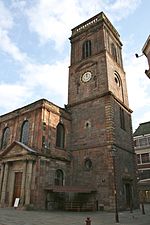Kendals
Art Deco architecture in EnglandDefunct department stores of the United KingdomDepartment store buildings in the United KingdomDepartment stores of the United KingdomGrade II listed buildings in Manchester ... and 4 more
HarrodsHouse of FraserRetailing in ManchesterUse British English from August 2015

Kendals is the previous name of a department store in Manchester, England. Since 2005, the store now operates as House of Fraser. The store had previously been known during its operation as Kendal Milne, Kendal, Milne & Co, Kendal, Milne & Faulkner, Harrods or Watts.
Excerpt from the Wikipedia article Kendals (License: CC BY-SA 3.0, Authors, Images).Kendals
Deansgate, Manchester City Centre
Geographical coordinates (GPS) Address Nearby Places Show on map
Geographical coordinates (GPS)
| Latitude | Longitude |
|---|---|
| N 53.4818 ° | E -2.2479 ° |
Address
House of Fraser
Deansgate 98-116
M3 2QG Manchester, City Centre
England, United Kingdom
Open on Google Maps











